|
Report from
Europe
Public comment invited on new FLEGT market report
Public comments are invited on a draft report by the
Independent Market Monitor (IMM), which is a multi-year
project implemented by ITTO and financed by the
European Union (EU) to support implementation of the
FLEGT Voluntary Partnership Agreements between the
EU and timber supplying countries.
The new IMM report reviews the latest data on forest
resources in VPA partner countries and on the timber trade
between partner countries and the EU during the 2014 to
2016 period. The report aims to establish the baseline
conditions for entry into the EU market of FLEGT
licensed timber.
Recognising that the first ever FLEGT licenses were
issued by Indonesia in November 2016, the report includes
additional commentary on the prospects for Indonesian
timber in the EU market.
The report also provides information on the status of
EUTR implementation and the market position of FLEGT
licensing in relation to private sector legality verification
and certification initiatives. The report concludes with
recommendations for future monitoring by IMM and
FLEGT-related communication.
The summary report is available at:
https://tinyurl.com/IMM-Summary
The main report is available at:
https://tinyurl.com/IMM-FLEGT-Main
Comments should be sent by email to:
technical@flegtimm.eu before 30 September 2017.
Tropical sawn wood imports decline in nearly all EU
countries
EU imports of tropical sawnwood in the first six months of
2017 were 348,600 metric tonnes (MT), 19% less than the
same period in 2016.
The decline was particularly pronounced for trade between
Cameroon and Belgium, following a surge last year, but
also affected nearly all exporting countries and EU
member states. The only minor exception was a slight
upturn in imports from Angola, mainly destined for
Portugal.
 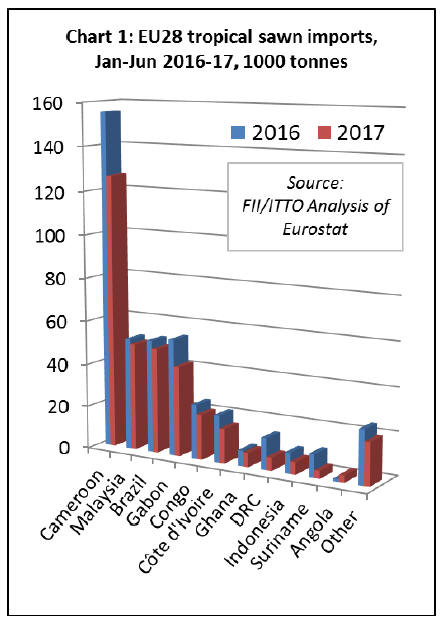 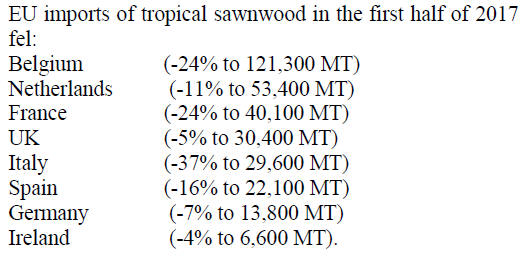
Imports in Portugal increased 20% to 15,500 MT during
the period (Chart 2).
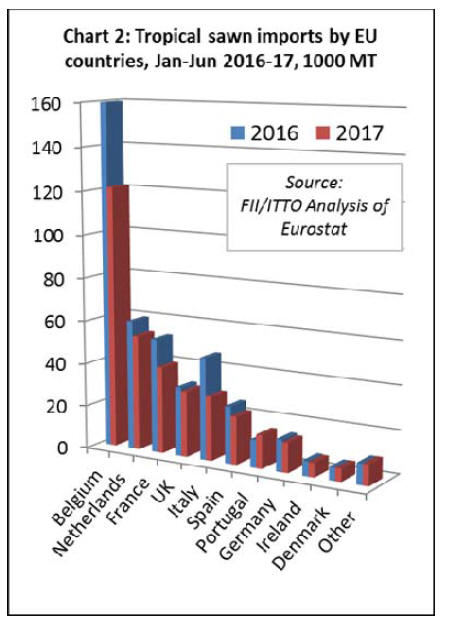
Weak consumption in the EU remains a factor behind the
decline in EU imports of tropical sawn wood in some parts
of Europe, notably Italy where the economy continues to
struggle.
However, this factor alone cannot explain such a
widespread downturn across the whole of the EU,
particularly as economic activity in the region has been
showing signs of improvement this year.
Some supply side issues have contributed to the decline in
EU trade this year. European importers complained of
long delays in shipment from Douala port during the first
half of 2017, although this factor can only have had a
short-term effect.
There are also indications that tropical exporters were
concentrating on other more profitable and less demanding
markets for sawn wood during the period. Malaysia is
focusing less and less on the European sawnwood market
these days, despite the country¡¯s considerable efforts to
meet the EU¡¯s demanding green procurement
requirements.
Malaysia¡¯s exports of sawnwood have increased sharply to
the Indian sub-continent and China this year. Brazil is
exporting more to the US and India. Gabon¡¯s exports of
sawnwood to China increased 35% in the first 6 months of
2017. With good demand elsewhere, supplies restricted,
the EU market still slow and difficult to satisfy as the EU
Timber Regulation begins to bite, and with rising
competition from modified temperate hardwoods, it¡¯s
almost inevitable that tropical sawn wood imports into the
region will continue to fall.
EU imports of tropical logs continue to slide
Tropical log imports into the EU fell in 2016 and this
decline continued in the first half of 2017. EU tropical log
imports declined 33% to 53,630 MT in the first half of
2017.
Imports declined from the four leading supply countries;
Congo (-42% to 12,760 MT), Cameroon (-37% to 9,150
MT), DRC (-46% to 8,530 MT), and the Central African
Republic (-45% to 6,400 MT).
These declines were partly offset by rising EU imports of
tropical logs from Equatorial Guinea (+10% to 5510 MT),
Angola (4420 MT from a negligible level in 2017), and
Liberia (+65% to 2730 MT). (Chart 3).
The EU trade in tropical logs is now concentrated in
France, Portugal and Belgium. Imports into all three
countries fell sharply in the first 6 months of 2017, down
62% to 18,700 MT in France, down 11% to 11,100 MT in
Portugal, and down 43% to 11,800 MT in Belgium.

Slight fall in EU imports of tropical decking
EU imports of ¡°continuously shaped¡± wood (HS code
4409), which includes both decking products and interior
decorative products like moulded skirting and beading,
were 90,555 MT in the first half of 2017, down 2% on the
same period in 2016.
Imports fell 6% to 39,000 MT from Indonesia and were
down 36% to 4,400 MT from Malaysia. These losses were
partly offset by a 6% rise in imports from Brazil, to 32,400
MT. (Chart 4).
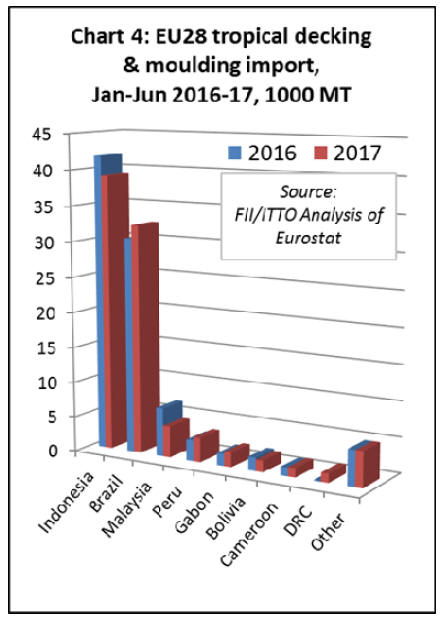
In the first half of 2017, imports of tropical decking and
mouldings increased 17% to 19,400 MT in France, but
declined into all other leading EU destinations including
Germany (-6% to 23,000 MT), Belgium (-10% to 15,800
MT), Netherlands (-16% to 15,400 MT), and the UK (-3%
to 5,600 MT).
EU imports of tropical veneer recover some lost
ground
EU imports of tropical hardwood veneer increased 3% to
78,400 MT in the first 6 months of 2017 compared to the
same period in 2016. The rise was mainly due to an 11%
increase in imports from Gabon, to 41,800 MT, building
on gains made the previous year.
This is due both to better consumption in the EU and to
rising investment in veneer production capacity in Gabon
which has been on-going ever since the country banned
log exports in May 2010.
Strong growth in EU imports of Gabon veneer in the first
half of 2017 was sufficient to offset declining imports
from Cote d¡¯Ivoire (-20% to 13,300 MT) and Cameroon (-
14% to 6,600 MT). (Chart 5).
Imports of tropical veneer declined into the two largest EU
markets in the first half of 2017, falling 5% to 29,500 MT
in France and 7% to 17,000 MT in Italy. However, these
losses were offset by larger increases in imports in Spain
(+10% to 11,500 MT) and Greece (+40% to 7700 MT).
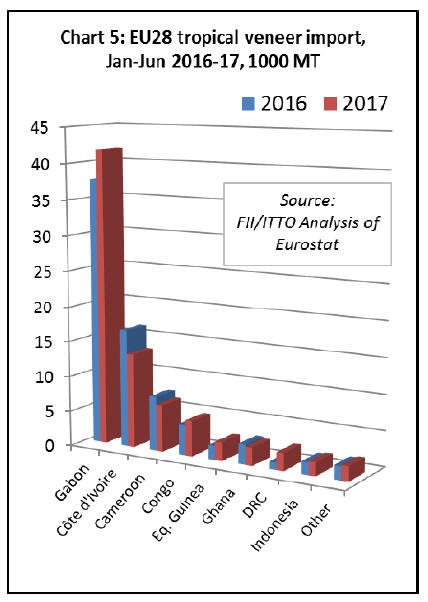
EU imports more tropical plywood, mainly from China
Plywood is one of the few sectors of the EU market where
tropical products have been performing reasonably well,
although much of the gain has been in indirect imports
from China rather than direct imports from tropical
countries. (Chart 6).
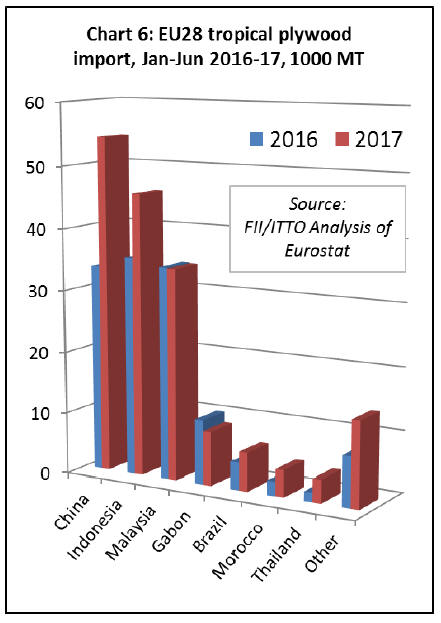
In the first six months of 2017, EU imports of products
faced with tropical hardwood manufactured in China
increased 62% to 54,300 MT, while direct imports from
tropical countries increased 21% to 171,100 MT.
Most of the gains in direct imports were from Indonesia,
rising 29% to 45,700 MT. Imports from Malaysia were
stable at 34,200 MT and imports from Gabon fell 16% to
8,700 MT in the first half of the year.
These are mixed results for those looking for evidence of
immediate market gains after issue of the first FLEGT
licenses in Indonesia at the end of last year. The 21% rise
in EU imports from Indonesia is encouraging and seems to
confirm early anecdotal reports that some EU importers
are favouring Indonesian product as it avoids the need for
time-consuming and expensive due diligence assessments.
On the other hand, plywood manufacturers in China, even
though using tropical hardwood veneers, appear to be
conforming to the EUTR due diligence requirements to the
satisfaction of many importers and regulators.
There are also reports that some plywood buyers in Europe
are still avoiding Indonesian plywood because of lack of
clear information on the exact species content when orders
are placed, usually a month or two before shipment.
Many Indonesian plywood mills do not know ahead of
time the exact mix of logs that will be available and
importers only have access to species information when
the order has been shipped and the FLEGT licence issued.
That conflicts with the internal procurement policies of
some large corporate buyers who now require, well in
advance, clear information on the exact species content of
all delivered timber products. Some of the larger Chinese
mills are better able to meet this requirement, while also
satisfying those buyers¡¯ needs for more regular large
shipments.
The rise in EU tropical plywood imports in the first half of
this year was mainly driven by the UK (+29% to 82,000
MT), Belgium (+52% to 30,300 MT), and Germany
(+24% to 11,000 MT). These gains offset a decline in
imports in the Netherlands (-29% to 16,400 MT) and
France (-20% to 10,300 MT).
Tropical glulam
EU imports of glulam from tropical countries increased
6% to 31,200 MT in the first six months of 2017. ¡®Glulam¡¯
here refers to all those products listed in code 44189910 of
the EU Combined Nomenclature and, with respect to
imports from tropical countries, includes mainly laminated
window scantlings and kitchen tops.
In the first half of 2017, EU imports of glulam from
Indonesia increased 26% to 13,000 MT. There was also a
42% increase in imports from Brazil, to 2,500 MT. In
contrast, imports fell 6% to 11,100 MT from Malaysia,
and were down 14% to 2,700 MT from Vietnam. (Chart
7).

From a FLEGT licensing perspective, there was an
encouraging increase in Indonesia¡¯s share of the EU
market for tropical glulam, from 35% last year to 42% in
the first half of this year.
The quantity of glulam and other engineered wood
products supplied by tropical countries into the EU is still
very modest.
There are also significant challenges for tropical suppliers
in this market ¨C notably intense competition from
European manufacturers and the requirement for often
complex technical standards. This is particularly true of
structural glulam products, none of which are currently
imported from the tropics.
However, demand for glulam and other engineered wood
products is rising in the EU and there may be a larger role
for tropical countries in this sector in the future,
particularly as it provides opportunities to add value to
smaller and lower grade wood material.
Another fall in EU imports of tropical hardwood
flooring
EU imports of tropical flooring products fell 11% to
18,700 MT in the first half of 2017, continuing a longterm
decline. Imports from Indonesia, the largest supplier
in 2016, declined 37% to 4,000 MT. This fall was only
partly offset by minor gains in imports from Brazil (+7%
to 5,300 MT), Malaysia (+3% to 5,100 MT), and Viet
Nam (+18% to 1,800 MT). (Chart 8).
Tropical wood flooring remains out of fashion in the EU
market which has become increasingly dominated by oak
and domestic European manufacturers. Share also
continues to be lost to a wide variety of non-wood
substitutes.

|